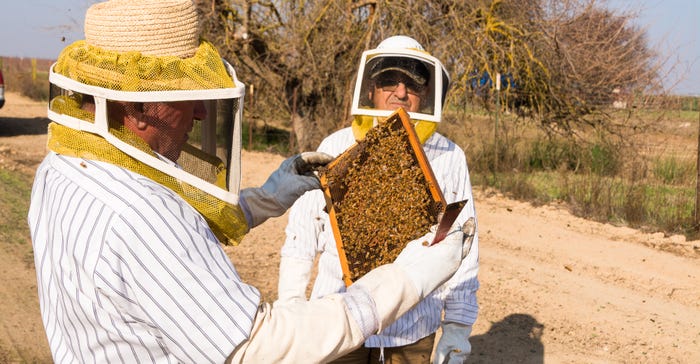
Honey bee inspector Neil Trent finds the queen in this frame as almond grower Arsen Alikian looks on.
Almond growers not inspecting bee hives when they first arrive, or having them inspected before the bloom, are setting themselves and the industry up for delivery of weak colonies for pollination.
Neil Trent is a bee inspector with Scientific Ag Company of Bakersfield, a company owned by bee broker Joe Traynor. Trent spoke with Western Farm Press recently about what he does and how almond growers can protect themselves during pollination.
Trent is a retired beekeeper who formerly rented bees for pollination through Traynor. About 12 years ago Trent retired from beekeeping and went to work for Traynor as a bee inspector.
“My job is to protect the farmer,” Trent says. That job includes inspecting hives for contract compliance – typically a minimum of eight frames on average. He also looks for signs of healthy hives, which will include:
Active bees, densely-packed in a single layer, spread across at least two-thirds of the frames in the colony; and,
Signs of a healthy brood.
Trent encourages almond growers to learn how to inspect hives and what to look for when doing those inspections, which he says should take place as soon as the hives arrive and before the trees begin to blossom.
Hives should be inspected between about 10 a.m. and 2 p.m. when the bees are active. Checking hives after bloom has begun can give a false sense of weaker colonies as bees then will not be in the hives, but working the trees.
The reason for eight frames is simple bee biology, Trent says. About three frames’ worth of bees will remain behind to attend to the hive. Those bees are feeding the brood, attending to the queen, ensuring a clean hive, and bringing in water to the hive. The remaining five frames in that eight-frame example will be working the trees.
In hives with only four to six frames, the same three frames of bees will remain behind to maintain the hive, leaving a much smaller workforce to forage for pollen and pollinate a crop, he says.
This is why Trent encourages growers to not simply count bee boxes, but know enough to open and inspect them, or have an inspector do that before the bloom begins.
Almond grower Arsen Alikian of Madera rents bees through Traynor’s brokerage, which provides Trent’s inspection services. Alikian likes the assurance Trent’s inspections provide.
“I had a lot of bad experiences in the old days when we didn’t have inspectors,” Alikian said. “We’d get bad hives and knew nothing about bee management, or what to do if the bees were bad.”
That’s why Trent likes to inspect hives well-before the bloom, so that if weak colonies are discovered, there is still time to order better colonies and have them delivered.
Trent also explains the necessity of strong bee colonies as a good policy in case of poor weather during the almond bloom. Bee flight hours can be significantly hampered by poor weather. Therefore, strong bees are necessary for periods when there are breaks in the weather – so they can quickly work orchards when the pollen dries. Bees will not work when the pollen is wet.
About the Author(s)
You May Also Like






